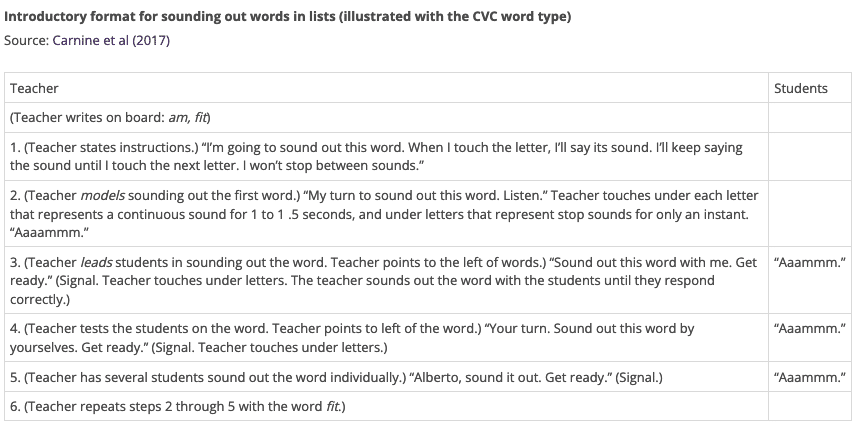Blending and segmenting
Home » Phonics » Essential principles of systematic and explicit phonics instruction » Blending and segmenting
Blending and segmenting are essential phonemic awareness skills for learning to read and spell. Blending and segmenting are also critical components of a synthetic phonics approach. Both of these skills are directly related to sounding out words. Segmenting breaks a word up into its component phonemes and blending puts them into a pronounceable word.
Read the following real words and pay attention to how you read them
For proficient readers, the process of segmenting and blending happens at an almost imperceptible speed until we come across a word that we have never encountered before. For a new and particularly lengthy word the sound by sound analysis process slows down and we become much more aware of the interplay between segmenting and blending.
Oral blending and segmenting
Blending and segmenting games can be played with children before they start school. Blending is the easier of the two skills so it should be introduced first. Oral blending games do not involve letters — they are listening and speaking games. Suggested activities can be found in the Parents Resources section. Phonological and phonemic awareness games can help sensitise children to the constituent sounds of the English language and this will assist them when learning phonics at school.
Because listening skills do not require knowledge of letters or grapheme-phoneme correspondences, they can be introduced on the first day of school. For a description of suggested activities see our phonemic awareness pages.
Before a beginning reader can segment and blend a written word they must have some knowledge of grapheme-phoneme correspondences. In a synthetic phonics approach a small set of grapheme-phoneme correspondences is taught that will allow the learner to begin to blend as soon as possible.
Carnine et al (2017) recommends that students know 4 – 6 letter sound correspondences before they are taught the strategy of sounding out. They also recommend passage reading not be introduced until students can read four regular words in a word list exercise without making an error. This recommendation assumes that students have come to the classroom with no prior knowledge of these skills. Of course students who enter school with prior knowledge will be able to progress at a much faster rate.
A well designed scope and sequence introduces graphemes in an order that facilitates the development of early and successful blending and segmenting. It is essential that decodable readers are used that are consistent with the school’s scope and sequence to allow students to practice the skills that they have learned in reading connected text.
The first words to work on with students should be regular words. Regular words are words that contain grapheme-phoneme correspondences that represent their most common sounds. ‘Dog’ is considered a regular word because each of the letters represents its most common sound, whereas the word ‘gem’ might be introduced later because the g is representing its less common /j/ phoneme.
These regular words should also have a simple VC (vowel/consonant) or CVC (consonant/vowel/consonant) structure. Letter by letter blending is more difficult when letter combinations are effected by coarticulation, therefore the consonants chosen for initial study should be continuous sounds because these are easiest for students to sound out and help students master blending and decoding more quickly (Gonzalez-Frey & Ehri, 2020). Continuous sounds allow the learner to ‘slide’ into the vowel to blend. Stop consonants can be introduced in the final position after students have demonstrated proficiency with continuous sounds.
Many published programs do not include specific instructions for teachers to explicitly teach students how to sound out words by blending. Carnine et al (2017) includes an introductory format for this so that teaching this critical concept is not left to chance. Further examples of how to teach blending and segmenting can be found in the Letters and Sounds – Phase 2 materials.
Once students have been introduced to sufficient grapheme-phoneme correspondences and they can segment and blend, they should begin practicing deletion, substitution and manipulation. Deletion involves removing a grapheme and reading the remaining word, for example, removing /f/ from flip, leaving ‘lip’. Substitution involves substituting /sh/ in ship with /ch/, resulting in ‘chip’. Manipulation involves games such as ‘sound swaps’, the example video here involved swapping the middle grapheme, but this should practiced with letters in the beginning and final positions too.
Practice with sound swaps helps build rapid recall of GPCs as well as segmenting and blending skills. Rapid recall of these skills helps build automaticity and frees up working memory so readers can concentrate on meaning and comprehension.

